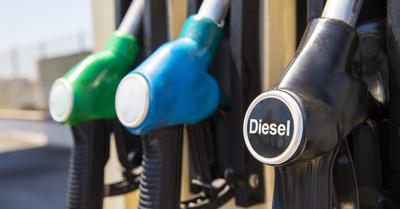As we approach the colder months, it's essential to understand how low temperatures can affect diesel fuel. This includes the diesel gelling temperature.
Diesel fuel tends to gel when temperatures fall between 10 and 15 degrees Fahrenheit. Gelling occurs as the paraffin wax in the fuel starts to solidify, creating a cloudy appearance and eventually clogging the fuel tank and lines.
Having tackled many challenges related to diesel vehicles, I've witnessed firsthand how frigid temperatures can affect diesel fuel and impede your vehicle's performance. This guide includes all the information you need to prepare your car for the cold months.
Key Takeaways
- Diesel fuel starts to gel when the temperature drops between 10 to 15 degrees Fahrenheit.
- If your diesel gels, move your vehicle to a warmer area, add winter rescue to the fuel, and remove the fuel filters and lines.
- Diesel gelling can happen after 48-72 hours of exposure to these cold temperatures.
This article may contain affiliate links where we earn a commission from qualifying purchases.
What Temperature Does Diesel Gel?
Diesel fuel will start to gel when cold temperatures of 10 to 15 degrees Fahrenheit happen. At this point, the fuel can clog up your tank and lines, leading to potential disruptions in your vehicle's diesel engine and operation.
Of course, different diesel fuel types might exhibit slightly different gelling temperatures. For example, No. 2 diesel fuel has a cloud point of 14 degrees. If the temperature drops even lower, it will reach the cold filter plugging point and cause major fuel tank issues.
To prevent diesel fuel from gelling, it's essential to use an anti-gel additive. Adding this to your fuel lowers the cloud point - the temperature at which diesel fuel starts to become cloudy due to the formation of crystals.
Anti-gel fuel additives can help ensure your fuel remains fluid and functional even in colder temperatures. It's crucial to be proactive and use anti-gel additives to prevent gelling, ensuring our vehicles and equipment run smoothly in cold weather.
How Long Does It Take For Diesel To Gel?
On average, it takes 48-72 hours of consistent exposure to freezing temperatures for diesel fuel gelling. This is enough time for the paraffin wax to solidify due to the cold temperatures.
The process may happen within hours or take days in extremely cold weather conditions. We know that diesel fuel begins to gel when temperatures drop and crystallization forms in the fuel, causing it to thicken and potentially clog the fuel filters and lines.
Diesel engines can start to feel the effects at 32 degrees F, but diesel fuel gels at much lower temperatures. This is because the fuel’s cloud point and pour point won’t be impacted until closer to 15 degrees.
Remember, diesel gelling can happen to anyone who operates in cold climates, so it's crucial to be prepared and take the proper preventive measures to keep our diesel engines running smoothly during the winter season.
Why Does Diesel Fuel Gel?
Diesel fuel contains paraffin, which can solidify and cause gelling in cold temperatures. This process typically starts at the cloud point, the temperature at which paraffin begins to precipitate in the fuel.
As the temperature drops, gelling can become more severe, clogging fuel lines and filters. This makes it difficult, if not impossible, for diesel engines to run in extremely cold weather.
When diesel fuel gels, it becomes much thicker and can't flow as freely through the vehicle's fuel system. This can lead to various problems, such as difficulties in starting the engine and, in severe cases, blocking the fuel lines and filter, causing the vehicle to stop running altogether.
Owners and operators of diesel equipment must be aware of the risks of diesel fuel gelling and take preventative measures. One popular option is using a winter fuel blend, which contains a higher concentration of lighter hydrocarbons, resulting in a lower pour point.
What To Do If Your Diesel Fuel Gels
When diesel fuel is subjected to cold temperatures, it can begin to gel, causing issues with the functionality and performance of your vehicle. Fortunately, if you find yourself in this predicament, there are several steps you can take to rectify the situation.
Move The Vehicle To A Warmer Area
First, we must act promptly to prevent further damage. If possible, move the vehicle to a warmer area, like a garage or well-insulated space. This will help the diesel fuel thaw and return to a more liquid state.
Even increasing the vehicle fuel’s temperature by a few degrees can make a huge difference when dealing with gelled diesel fuel. This will allow it to flow freely through the fuel lines and filter, returning your vehicle to regular operation.
Be patient, though, as this can take some time, depending on the initial degree of gelling and the ambient temperature of the warmer area.
Add Diesel Winter Rescue To The Fuel Tank
If moving your diesel vehicle isn't feasible, you can use fuel additives explicitly designed to prevent and treat diesel fuel gelling, such as a Diesel Winter Rescue. These additives lower the freezing point of diesel fuel, preventing it from gelling in cold temperatures.
To use a Diesel Winter Rescue, pour the recommended amount directly into the fuel tank. This additive works by dissolving the gelled fuel back into the solution, thus restoring the flow of fuel to your engine.
This is good to have at home if you own diesel equipment or diesel vehicles, especially if you live in a cold region where frozen fuel or a frozen fuel system is standard.
Remove The Fuel Filter & Fuel Lines
It's also essential to keep the fuel filters clean and free of any wax or debris, as these can contribute to diesel fuel gelling and impact the vehicle's performance. Gelled fuel can clog these components, preventing fuel flow to the engine.
By replacing the filter and lines, you can ensure the fuel path is clear. However, this can be a challenging task and could potentially cause other complications if not done correctly.
Bear in mind that if you're not experienced with automotive repair, it's always a good idea to leave such tasks to a trained mechanic. Even after replacing these parts, the vehicle may still need to be warmed up, or a de-gelling agent may need to be added to restore its functionality fully.
How To Prevent Diesel Fuel From Gelling
Below are a few strategies that can help you keep your diesel fuel in a liquid state and your vehicle running smoothly.
Add Fuel Additives
Fuel additives, also known as anti-gel additives, are specifically designed to lower the gelling temperature of diesel fuel.
They work by modifying the size and shape of paraffin crystals that form in the fuel at low temperatures, preventing them from clumping together and clogging the fuel system.
Install a Fuel Tank Heater
Another effective way to prevent diesel fuel gelling is installing a fuel tank heater. These heaters maintain the temperature of the fuel above the point at which gelling occurs.
This ensures that the fuel stays liquid and flows freely through the fuel system. They can be beneficial for vehicles that need to be parked outdoors in cold weather.
Keep The Tank Full
By keeping your fuel tank full, especially overnight, you can slow the rate at which the fuel cools down, thus decreasing the chances of gelling. A full tank has less air and, therefore, less opportunity for condensation to form, which can also lead to fuel line freezing.
How Do I Know If My Diesel Fuel Is Gelled Up?
Recognizing the signs of diesel fuel gelling can be crucial to avoiding more serious problems. Here are some common symptoms that might indicate your diesel fuel is beginning to gel.
- Difficulty Starting: One of the first signs that your diesel fuel might be gelling is that the engine is difficult to start, particularly in cold weather. If the diesel fuel is starting to gel, it may not provide sufficient flow to the engine, making it hard to get the engine to turn over.
- Loss of Power: If your vehicle seems to be lacking its usual power or is not accelerating as it should, it could be because the gelled fuel is not adequately reaching the engine.
- Engine Misfires or Runs Roughly: If the engine is running unevenly or if you notice misfires, it could be a sign that the fuel supply is being compromised by gelling.
- Engine Stalls: In severe cases, gelling can cause the engine to stall. This typically occurs because the fuel has become so thick that it can no longer flow through the fuel system, essentially starving the engine of the fuel it needs to run.









